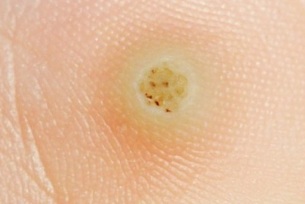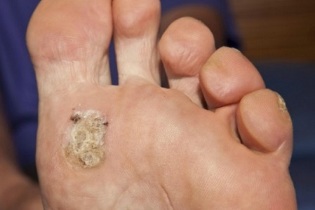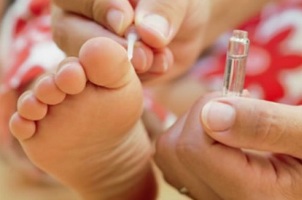
If a hard and rough papule with a rough surface appears on the soles of the feet, then it is either plantar warts or coconut. The differences are significant primarily in the origin and methods of treatment. The wart grows in the inner layer of the skin of the foot like a sharp thorn, causing severe pain. Doctors recommend removing this swollen skin if it is damaged by shoes and becomes inflamed.
The appearance of a growth at the base of the foot
The main part of the main wart grows inside the feet, in the dermis. The reason is that from the outside the tumor ends with solid surfaces: shoes, different types of cover on which we walk. New growth cells emerge from the soft tissues of growth. In a photo of a plantar wart, a dense plaque or roller can be seen from the outside. The formation surface is devoid of skin lines, consisting of corneal scales. Adjacent skin changes: becomes denser, covered with a layer of keratin.
What are plantar warts:
- nodule or plaque that grows 1-5 mm above the epidermis;
- Shape is round, oval or polygonal;
- The surface is hard and rough to the touch;
- Pink, yellow-white or grayish color;
- Formation diameter from 1 to 20 mm;
- Papillary pattern is missing;
- edges well defined.
Foot warts are characterized by severe pain that prevents walking until temporary disability.

Accumulation occurs in areas that experience severe pressure and sweating. Typical localization of the wart on the foot: heels, foot and toe pads. Painful and difficult to remove growths appear at the edge of the nail and under the nail plate. Inside all types of warts are blood vessels that feed on living tissues, cells that multiply intensively. Small black dots appear on the surface - thrombi in capillaries; They may bleed when cutting the stratum corneum.
Plantar warts are most common in school-age children. In about 30% of patients, such formations disappear on their own within the first year. However, it is recommended to start treatment when the first symptoms appear, especially if the plantar warts hurt or there is a high risk of infection of those around you. Infection is also dangerous when a group of growths appears in one zone, separate papules merging with the mosaic board.
Wart - Papilloma virus manifestation
The skin on the feet is often damaged, compressed and sweaty when wearing tight and uncomfortable shoes. If thin-walled blisters appear inside the clear liquid, then it is corns. Sometimes a layer of keratin forms on the surface, but even so, the typical lines of the skin remain.
The appearance of a wart on the soles of the feet goes unnoticed or is perceived as a call. You need to carefully examine the surface of the formation and pay attention to the characteristic marks. This is acute keratinization, lack of skin lines, pain when the surrounding skin is compressed. This is the result of active reproduction of the papilloma virus in living cells of the epithelium.Causes of Plantar Warts:
- Papillomavirus (HPV) infection;
- Weakening of local and general immune defenses;
- virus activation, penetration into epithelial cells;
- increased proliferation and rapid keratinization of infected cells.
HPV is transmitted through household and sexual contact. Infectious agents penetrate even with minor damage to the skin and mucous membranes: cracks, cuts, weeping.
Types of papilloma viruses of types 1, 2, 4, 27 and 57 mainly infect cells in the skin of the foot. The plantar type of viral origin belongs to the simple formations (ordinary, vulgar). According to the International Classification of Diseases, they are infectious and parasitic diseases. ICD-10 Class: "Viral infections characterized by damage to the skin and mucous membranes. "
Simple warts are benign epithelial tumors. They do not initially pose a health hazard. Sometimes such tumors undergo a malignant transformation into a cancerous tumor. The process is more likely to cause HPV types, which have a higher risk of developing cancer.
Treatment of foot warts
The incubation period begins after infection: the papilloma virus invades the cells, "forming" their reproduction and development. Much more often, the infection becomes latent and in such an inactive state it can exist throughout the life of the organism. Immunity in this case suppresses the papilloma virus, putting it to sleep without special therapy.
Plantar warts may appear after 3-10 years or a few weeks after infection, then disappear within the first year or two.
Not all are ready to wait, hoping for spontaneous healing of the skin and cleansing of the skin from growths. Many go to the doctor at the first sign of HPV infection. Dermatologists offer modern methods of getting rid of warts, recommend means for antiviral therapy, to strengthen the skin and the immune system of the whole body.
If an adequate choice of therapy is needed to determine the type of HPV, your doctor will order several additional tests. A biopsy is performed to collect histological material, and an analysis is performed to detect antibodies to the papilloma virus.

Treatment options:
- Use of special medications for plantar warts. Dead cells disintegrate and exfoliate.
- Laser excision of simple neoplasms to produce a cortex under which healing takes place. The bark disappears 7-10 days after the procedure.
- Cryodestruction with liquid nitrogen. Large warts can be removed with several procedures. Upon exposure to low temperatures, a bubble appears as after a burn.
- Electrocoagulation using an electrode that conducts high-frequency current to destroy abnormal tissues. Painful procedure accompanied by a strong odor of skin burning.
- Surgical removal.
- drug injection.
It is recommended to use a special plaster at home at the beginning of treatment. This affordable remedy is used after softening the wart on the foot with warm water, cleansing it from the corneal layer with nail scissors and pumice. Then a patch is applied. The course of treatment lasts on average 1-3 months.
Prevention
Papilloma viruses can live in the environment for a long time. It is necessary to keep your feet clean, do not walk without shoes, especially in public dressing rooms, bathrooms, swimming pools. It is necessary to use special slippers to protect the soles of the feet from surfaces contaminated with other people's skin particles. Also, do not wear someone else's socks and shoes.
Do not wake the wart, otherwise similar growths will appear on other parts of the foot.
Papilloma viruses are highly contagious. Disinfection of accessories for daily hygiene and use of medicines. Socks and foot towels should be thoroughly washed with hot water, scissors, nail bandage, pumice should be disinfected. Be sure to wash your hands with soap and water after touching education, various medical procedures.














































































